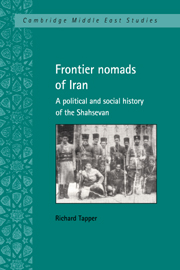Book contents
- Frontmatter
- Contents
- List of illustrations
- Preface
- Acknowledgments
- Note on transliteration
- Glossary
- 1 Writing tribal history
- PART I The Safavid state and the origins of the Shahsevan
- PART II The rise of the Shahsevan confederacy
- PART III The Shahsevan tribes in the Great Game
- PART IV The end of the tribal confederacy
- 11 Pastures new: the effects of the frontier closure
- 12 The Shahsevan, the Constitution, the Great War and after
- 13 Settlement and detribalization
- 14 Conclusion: Shahsevan identity and history
- Appendices
- Bibliography
- Index of topics
- Index of places, peoples, persons, dynasties, parties, companies
- Index of authors quoted or discussed
- Index of tribal names
- Plate section
14 - Conclusion: Shahsevan identity and history
Published online by Cambridge University Press: 05 March 2012
- Frontmatter
- Contents
- List of illustrations
- Preface
- Acknowledgments
- Note on transliteration
- Glossary
- 1 Writing tribal history
- PART I The Safavid state and the origins of the Shahsevan
- PART II The rise of the Shahsevan confederacy
- PART III The Shahsevan tribes in the Great Game
- PART IV The end of the tribal confederacy
- 11 Pastures new: the effects of the frontier closure
- 12 The Shahsevan, the Constitution, the Great War and after
- 13 Settlement and detribalization
- 14 Conclusion: Shahsevan identity and history
- Appendices
- Bibliography
- Index of topics
- Index of places, peoples, persons, dynasties, parties, companies
- Index of authors quoted or discussed
- Index of tribal names
- Plate section
Summary
On ethnicity and identity
In the opening chapter I showed how anthropologists have failed to agree on a substantive definition of ‘tribe’, arguing that as an analytical concept it is best used – and best matches indigenous concepts – for a ‘state of mind’, a mode of social organization essentially opposed to that of a centralized state. Some of the problems anthropologists have had with the concept of ‘tribe’ are echoed in debates over concepts of ‘ethnicity’ and ‘identity’. I do not intend to review those debates here, but only to make clear my own perspective, which is the same as that employed in the discussion of ‘tribe’.
One dominant approach to ‘ethnic groups’ in history and anthropology has conceived them to be, or to approximate, bio-genetically self-perpetuating populations, whose members share elements of a common culture, identify themselves and are identified by others as a separate category. This ‘primordialist’ approach, fundamentally positivist and objectivist, is a refinement of an older anthropological tradition in which ‘cultures’ were treated as co-terminous with ‘tribes’, ‘societies’, ‘peoples’. Even if adherents of this approach do not all take the genetic assumptions too literally, they still present populations as divided into formally bounded, clear-cut, ethnic groups, with every person belonging to one: a conception that facilitates tidy maps, neat lists of the traits associated with each group, a rigorous classification of types, and cross-cultural comparison.
The flaws in such a conception have become increasingly clear, not least its disregard for the identity claims of the populations concerned and for other cleavages such as those of class that might divide those populations.
- Type
- Chapter
- Information
- Frontier Nomads of IranA Political and Social History of the Shahsevan, pp. 315 - 348Publisher: Cambridge University PressPrint publication year: 1997



